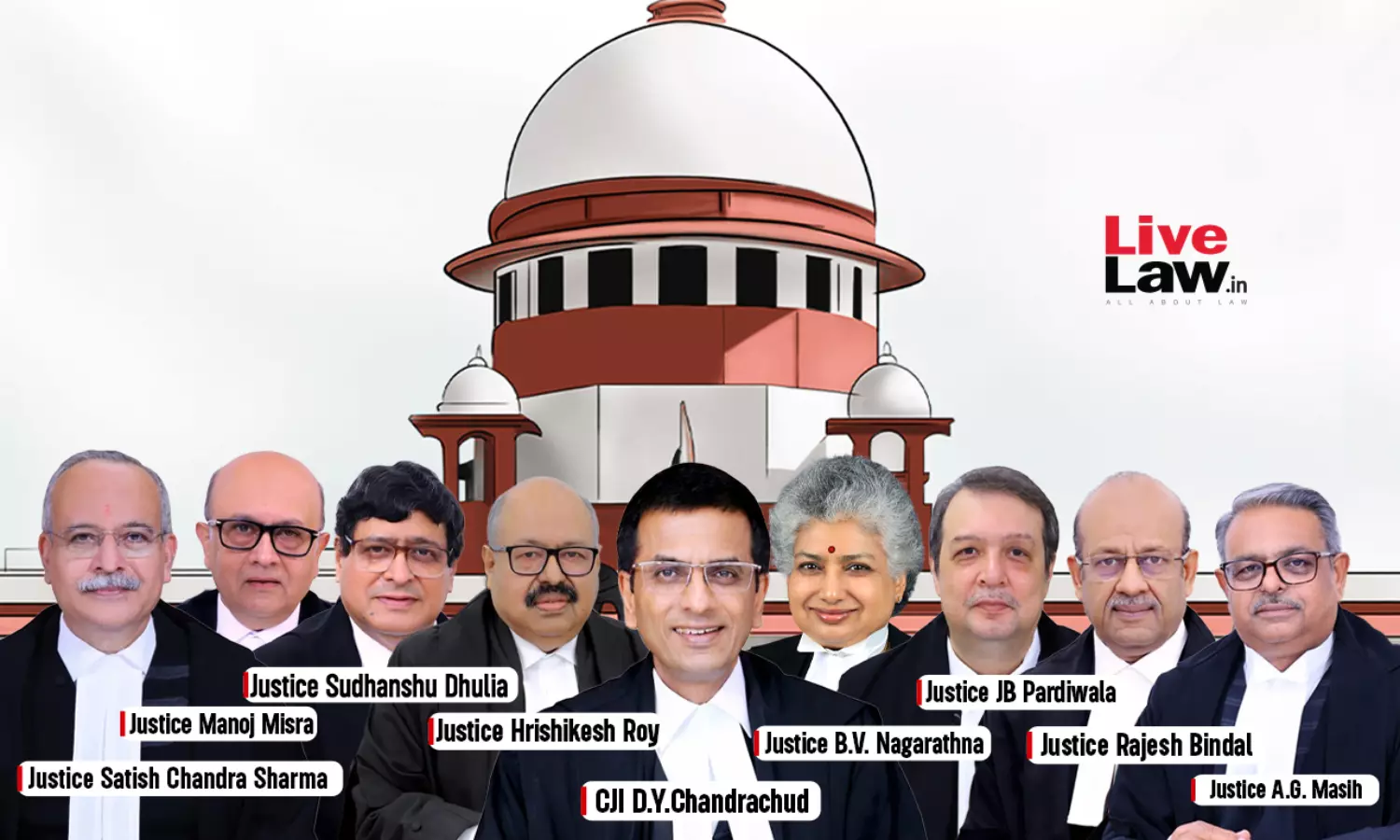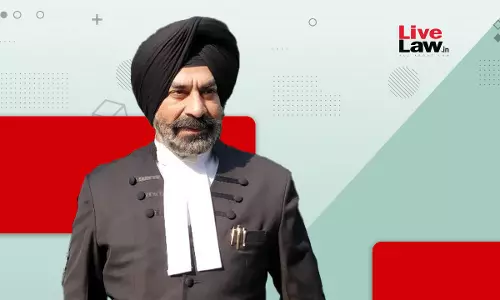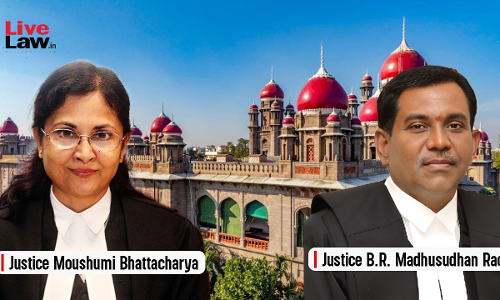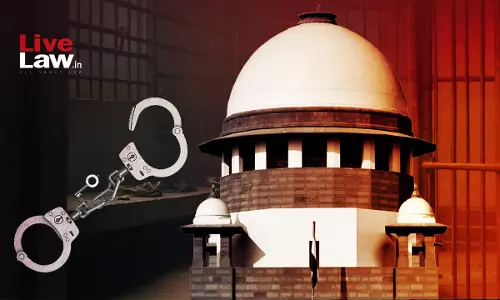Are Private Properties Included In "Material Resource Of Community" Under Article 39(b)? Supreme Court 9-Judge Bench Reserves Judgment

The Supreme Court Constitution Bench today (May 1) reserved its judgement on the issue of whether private resources form part of the 'material resource of the community' under Article 39(b) of the Constitution. The Court concluded the hearing after 5 days of arguments raised on the issues of what constitutes a community, the subjective under tones of 'material resource' as well as the fate...
The Supreme Court Constitution Bench today (May 1) reserved its judgement on the issue of whether private resources form part of the 'material resource of the community' under Article 39(b) of the Constitution. The Court concluded the hearing after 5 days of arguments raised on the issues of what constitutes a community, the subjective under tones of 'material resource' as well as the fate of Article 31C post the decision in Minerva Mills v. Union of India.
The 9-judge bench considering the issue comprises Chief Justice of India DY Chandrachud, Justices Hrishikesh Roy, B.V. Nagarathna, Sudhanshu Dhulia, J.B. Pardiwala, Manoj Misra, Rajesh Bindal, Satish Chandra Sharma and Augustine George Masih.
The appellants' side was mainly represented by Senior Advocate Zal T. Andhyarujina and Mr Sameer Parekh. The Union was represented by Attorney General Mr R Venkataramani, Solicitor General Mr Tushar Mehta. Senior Advocates Mr Gopal Sankaranarayanan, Harish Salve and Rakesh Dwivedi additionally raised arguments on behalf of thethe respondents' side.
The batch of petitions initially arose in 1992 and was subsequently referred to a nine-judge bench in 2002. After more than two decades of being in limbo, it was taken for hearingin 2024. The main question to be decided is whether material resources of the community under Article 39(b) (one of the Directive Principles of the State Policy), which states that the government should create policies to share community resources fairly for the common good, includes privately owned resources. Article 39(b) reads as follows:
"The State shall, in particular, direct its policy towards securing-
(b) that the ownership and control of the material resources of the community are so distributed as best to subserve the common good;”
The issue in these petitions revolves around the constitutional validity of Chapter-VIIIA, introduced in 1986 as an amendment to the Maharashtra Housing and Area Development Act,(MHADA) of 1976. Chapter VIIIA deals with the acquisition of specific properties, wherein the State requires payment at a rate equivalent to one hundred times the monthly rent for the premises in question. Section 1A of the Act also incorporated through the 1986 amendment, states that the Act is designed to implement Article 39(b) of the Constitution.
A three-judge bench first heard this matter. In 1996, it was referred to a five-judge bench, which then referred to a seven-judge bench in 2001. Eventually, in 2002, the matter was put before a nine-judge bench.
The reference was with regard to the interpretation of Article 39(b) of the Constitution. Put shortly, in State of Karnataka v. Ranganatha Reddy & Anr. (1978), two judgments were delivered. The judgment delivered by Justice Krishna Iyer stated that material resources of the community covered all resources– natural and man-made, publicly and privately owned. The other judgment, delivered by Justice Untwalia, did not consider it necessary to express any opinion with regard to Article 39(b). However, the judgement stated that the majority of Judges did not subscribe to the view taken in respect of Article 39(b) by Justice Iyer. The view taken by Justice Iyer was affirmed by a Constitution Bench in the case of Sanjeev Coke Manufacturing v. Bharat Coking Coal Ltd. (1982). This was also affirmed by a judgment in the case of Mafatlal Industries Ltd. v. Union of India.
The seven-judge bench in the present matter stated that this interpretation of Article 39(b) required to be reconsidered by a Bench of nine learned Judges. It held–
"We have some difficulty in sharing the broad view that material resources of the community under Article 39(b) covers what is privately owned."
Accordingly, the matter was referred to a nine-judge bench in 2002.
Arguments Raised By The Appellants
The main contention raised by the appellants and other intervenors was that the term 'Material Resource' under Article 39(b) is to be interpreted as any resource which is capable of generating wealth - through goods or services for the larger good of the community. If the intention of the law was to include private resources within the meaning of 'Material resources', the drafter would have done so in order to avoid any possible future misinterpretations.
Relying on paragraphs 80-81 of the decision in State of Karnataka v. Ranganatha Reddy & Anr., the Counsels then contended that Justice Krishna Iyer intended to keep the notion of 'nationalisation' into focus. However, the appellants cautioned against misunderstanding nationalisation to mean taking one's private property and giving to another. Concerns were also raised about the perceived extremity of Justice Krishna Iyer's advocacy for widespread acquisition and redistribution of private property. The court was cautioned against adopting an overly Marxist interpretation, emphasizing the need to balance redistribution objectives with property rights.
Another area of discussion was the interrelation between 31C and 39(b). Article 31C was perhaps a safety net for laws made under Article 39(b). Thus it was imperative for the Court to decide on the question of effectiveness of Article 31C in a post-Minerva Mills regime. Thus, after S.4 of the 42nd Amendment which changed Article 31C was declared unconstitutional, would that lead to a revival of the original Article 31C? The appellants contended that it perhaps wouldn't and requires legislative interference to make a law on the same.
Arguments Raised By The Union
On the other hand, the Union contended that the decision in Minerva Mills only strikes out the amended version brought by S.4 of the 42nd Amendment while the upheld version by the decision in Kesavananda Bharati would still survive. It was asserted by the Union and other respondents that as per the Blackstone's Declaratory Doctrine, the moment the Court in Minerva declare S.4 of the 42nd Amendment Act as invalid, the unamended version automatically survives, and it is not the role of the Court to expressly clarify the position of law which would encroach the ambit of the legislature.
The Union highlighted that the interpretation of Article 39(b) should be from the standpoint of the ever-expanding constitutional principles and not any ideology. In terms of understanding a resource, the Union urged that it is a community's dynamic interactions that mould the meaning of 'Material Resources'. In a community, different individuals have different interactions and business transactions. This makes the sum total of a community's wealth, to which each individual through its economic interactions contributes. Thus 'resource' under Article 39b means a common economic base.
The Union explained that what makes a thing a 'resource' has to be understood from the broader constitutional ideal of 'public goods'. While the initial focus of resources of public good as borrowed from Utopian or Socialist ideologies would have been limited to tangible assets like factories or land, especially in the 18th and 19th centuries, the true meaning of resource will always focus on the State's responsibility for subserving the common good. The extent of the State's interference in controlling and regulating these resources, however always remains a contemporary topic of discussion.
Case Details: Property Owners Association v. State of Maharashtra (CA No.1012/2002) & Other Connected Matters
Reports of the hearing :




